Podcast: Play in new window | Download (Duration: 21:53 — 22.6MB)
It’s the next in our short series of episodes about mass extinctions! Don’t worry, it won’t be boring, because we’re going to learn about a lot of weird ancient fish too.
Further reading:
Titanichthys: Devonian-Period Armored Fish was Suspension Feeder
Behind the Scenes: How Fungi Make Nutrients Available to the World
Dunkleosteus was a beeg feesh with sharp jaw plates that acted as teeth:
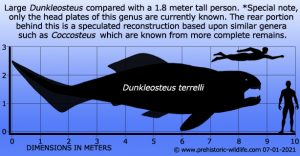
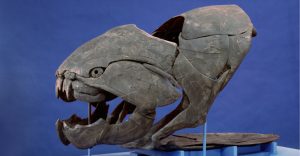
Titanichthys was also a beeg feesh, but it wouldn’t have eaten you (picture from the Sci-News article linked above):
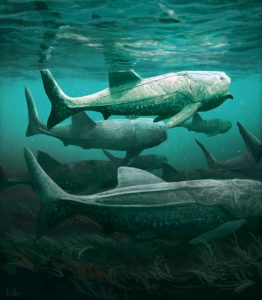
Pteraspis: NOSE HORN FISH:
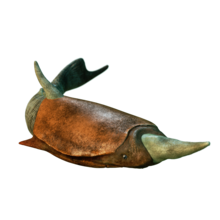
Cephalaspis had no jaws so it couldn’t chomp you:
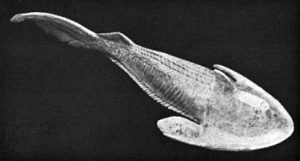
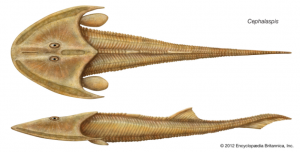
Bothriolepis kind of looked like a fish in a mech suit:
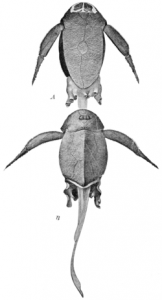
Show transcript:
Welcome to Strange Animals Podcast. I’m your host, Kate Shaw.
Here’s the second in our small series of episodes about extinction events, this one the Late Devonian extinction. We’ll also learn about some weird and amazing fish that lived during this time, and a surprising fact about ancient trees.
The Devonian period is often called the Age of Fish because of the diversity of fish lineages that arose during that time. It lasted from roughly 420 million years ago to 359 million years ago. During the Devonian, much of the earth’s landmasses were smushed together into the supercontinent Gondwana, which was mostly in the southern hemisphere, and the smaller continents of Siberia and Laurussia in the northern hemisphere. The world was tropically warm, ocean levels were high, and almost all animal life lived in the oceans. Some animals had adapted to living on land at least part of the time, though, and plants had spread across the continents. The first insects had just evolved too.
Shallow areas of the ocean were home to animals that had survived the late Ordovician extinctions. There were lots of brachiopods, bivalves, crinoids, trilobites, and corals. Eurypterids were still thriving and ammonites lived in deeper water. But while all these animals are interesting, we’re mainly here for the fish.
The fish of the Devonian were very different from modern fish. Most had armor. Way back in episode 33 we talked about the enormous and terrifying dunkleosteus, which lived in the late Devonian. It might have grown up to 33 feet long, or 10 meters. Since we still don’t have any complete specimens, just head plates and jaws, that’s an estimate of its full size. However long it grew, it was definitely big and could have chomped a human in half without any trouble at all. It’s probably a good thing mammals hadn’t evolved yet. Instead of teeth, dunkleosteus had jaw plates with sharp edges and fanglike projections that acted as teeth.
Another huge fish from the Devonian is called titanichthys, which might have grown as long as dunkleosteus or even bigger, but which was probably not an apex predator. Its jaw plates were small and blunt instead of sharp, which suggests it wasn’t biting big things. It might not have been biting anything. Some researchers think titanichthys might have been the earliest known filter feeder, filtering small animals from the water by some mechanism we don’t know about yet. Filter feeders use all sorts of adaptations to separate tiny food from water, from gill rakers to baleen plates to teeth that fit together closely, and many others. A study published in 2020 compared the jaw mechanisms of modern giant filter feeders (baleen whales, manta rays, whale sharks, and basking sharks) to the jaw plates of titanichthys, as well as the jaw plates of other placoderms that were probably predators. Titanichthys’s jaws are much more similar to those of modern filter feeders, which it isn’t related to at all, than to fish that lived at the same time as it did and which it was related to.
Titanichthys and dunkleosteus were both placoderms, a class of armored fish. That wasn’t unusual, actually. In the Devonian, most fish ended up evolving armored plates or thick scales. What was unusual in placoderms were their jaws. Specifically, the fact that they had jaws at all. Placoderms were probably the first fish to evolve jaws.
Pteraspis, for instance, was an armored fish that wasn’t a placoderm. It had no fins at all but it was a good swimmer, streamlined and possibly a predator, although it might have been a plankton feeder at the surface of the ocean. It grew about 8 inches long, or 20 cm. It used its tail to propel itself through the water, and instead of fins it had spines growing from its armor that helped keep it stable. A spine on its back, near the rear of the body armor, acted as a dorsal fin, while spines on the sides of its armor, just over its gills, acted like pectoral fins. It also had some smaller spines along its back and a big spike on its nose. Probably not a good fish to swallow whole.
Cephalaspis lived in the early Devonian, around 400 million years ago in fresh water. It wasn’t very big, maybe a foot long, or 30 cm. Basically, it would have fit nicely on a dinner plate, but it wouldn’t have looked much like a trout other than its size. It wasn’t a placoderm either although it did have armor. It was probably a bottom feeder and was flattened in shape with a broad, roughly triangular head covered in armor plates. Its eyes were at the top of its head and its mouth was underneath. The rest of its body was thinner and tapered to a thin tail. It probably used its head to dig around in the mud and sand to find small invertebrates, which it slurped up and swallowed whole because it had no jaws to bite with.
In comparison, the placoderm bothriolepis was about the same size as cephalaspis and was also a bottom feeder in fresh water, but that’s where the resemblance ends. It lived later, around 375 million years ago, and probably ate decomposing plant material. Like other placoderms, it had armored plates on its head and the front part of its body. The armor at the front of its head had a little opening for its eyes, which were really close together. Its tail wasn’t armored and was probably only covered in skin without scales. Bothriolepis also had long armored pectoral fins that look sort of like spikes. Its head armor was so heavy that it probably used these spike-like fins to help push itself off the bottom. The pectoral fins of some bothriolepis species had an elbow-like joint as well as a joint at the top of the fin, making them more arm-like than fin-like. Basically, bothriolepis looks like a fish wearing a mech suit that doesn’t cover its tail. It looks like an armored box with a fish tail and spikes for arms. It looks weird.
Bothriolepis was really common throughout the world with lots of species known. The largest was B. rex, which grew up to 5 1/2 feet long, or 1.7 meters, and which had thicker armor than other placoderms. Researchers think its heavy armor would have kept it from being swept to the surface by currents. Most bothriolepis species were much smaller, though.
Because it was so common, we know quite a bit about bothriolepis. In addition to the fossilized armor plates, we have some body impressions and even fossilized internal organs. This is really rare, and the reason it’s happened more than once in bothriolepis is that the internal organs were protected by the armor plates long enough for fine sediment to fill the body before the organs decomposed or were eaten by other animals. We know that the digestive system was simple compared to modern fish but the gut was spiral shaped, which allowed more time for the plant material it ate to stay in the body so more nutrients could be extracted from it. The gills were likewise primitive, and it may have also had a pair of primitive lungs. Yes, lungs! Not all palaeontologists agree that the sacs were actually lungs, but those who do think the fish would have gulped air at the surface like a lungfish. Since most, if not all, bothriolepis species seem to have lived in freshwater, it’s possible it needed lungs to breathe air if the water where it lived was low in oxygen. Some researchers think it might even have been able to use its pectoral fins to move around on land, at least enough to move to a new water source if its home dried up. Because bothriolepis remains are sometimes found in marine environments, some researchers also speculate that it may have migrated from or to the ocean to spawn, and that it used its possible land-walking ability to navigate around obstacles while migrating along rivers.
At least some bothriolepis individuals also had a pair of weird frills at the base of the tail. They might have acted as fins but they might have had something to do with mating, like a male shark’s claspers. It’s not clear if all individuals had them or only some.
Placoderms were the first fish to develop jaws, teeth, and pelvic fins. Pelvic fins were important not just because it made the fish more stable in the water, but because they correspond to hind legs in tetrapods. Here’s something to think about: if pelvic fins hadn’t evolved in fish, would land animals have eventually evolved four legs or would all land animals have just two legs and a tail? Would humans look like mermaids and mermen, or weird seals? Would birds have evolved wings even if it meant they had no feet?
Okay, so, back to the Devonian. There were lots more fish than just the placoderms, of course. Coelacanths, lungfish, and early sharks evolved at this time and are still around, as are ray-finned fish that are the most common fish today.
But maybe with all this talk of weird fish, you’ve forgotten this is an episode about an extinction event. Ocean life in the Devonian was chugging along just fine–but then something happened, something that resulted in the same loss of oxygen in the oceans that caused so many extinctions in the late Ordovician. But no one’s sure what that was.
The extinction event actually took place in several waves millions of years apart. Researchers generally think that the same events that caused the late Ordovician extinction events may have caused the late Devonian extinction events. Toward the end of the Devonian the Earth did appear to go through several rapid temperature changes, and some researchers think the cause of these temperature changes might have been trees.
At the beginning of the Devonian, there were lots of plants on land, but they were all small. You could walk from one side of a continent to another and never encounter a plant taller than knee-high. But plants were evolving rapidly, and before long the first trees appeared. They were related to ferns, club moss, and a type of plant called horsetails, which wouldn’t have looked much like trees to us. The progymnosperms also evolved during this time, and they were ancestors of modern gymnosperms, a group which includes conifers, gingkos, and cycads. Some of these early trees didn’t even have leaves, while some had what looked like fern fronds. Some grew almost 100 feet tall, or 30 meters.
Tall trees need strong roots, and roots loosened the soil and underlying rocks to great depths. This made it more likely that heavy rains would wash soil into the water, potentially causing microbial blooms. All these trees also absorbed enormous quantities of carbon dioxide and released oxygen into the atmosphere. This sounds great, because animals need oxygen to breathe! But as trees spread across the land, growing bigger and taller, they absorbed as much as 90% of the available carbon dioxide, so much that it actually caused the earth to cool enough to cause glaciers to form.
One interesting thing about trees. Trees and other plants contain complex polymers called lignin that harden the cells. Lignin is why trees have bark and wood. Lignin is also really resistant to decay, which is why it takes so long for a fallen tree to rot down into nothing. There are specialized bacteria and fungi that can break down lignin, but most bacteria and fungi can’t affect it at all.
Plants first evolved lignin around 400 million years ago, and early trees contained a lot of it, way more than modern trees have. It took bacteria and fungi a long time to evolve ways to break that lignin down to extract nutrients from it—around 100 million years, in fact. So for 100 million years, whenever a storm knocked over a tree and it died, its trunk just…stayed there forever–or at least for a really long time, becoming more and more buried over the centuries. Lignin isn’t water soluble either, so even trees that fell into a lake didn’t rot, or at least the lignin in the trunks didn’t rot. All those tree trunks were eventually compressed by the weight of the soil above them into coal beds.
Anyway, the peak of this cycle of trees absorbing carbon dioxide and releasing oxygen actually happened in the Carboniferous period, which occurred just after the final wave of the Devonian extinctions. That’s why insects could grow so incredibly large during the Carboniferous, because the atmosphere contained so much oxygen.
But in the build-up to the late Devonian extinction events, there were periods of colder and warmer climate worldwide, possibly caused by trees, possibly by other factors, most likely by a combination of many factors. Glaciers would form and melt rapidly, possibly leading to the same issues that caused the late Ordovician extinction events.
I’ll quote a bit from episode 205 to remind you what scientists think happened in the Ordovician when a whole lot of glaciers suddenly melted:
As the glaciers melted, cold fresh water flowed into the ocean and may have caused deep ocean water to rise to the surface. The deep ocean water brought nutrients with it that then spread across the ocean’s surface, and this would have set off a massive microbial bloom.
Microbial blooms happen when algae or bacteria that feed on certain nutrients suddenly have a whole lot of food, and they reproduce as fast as possible to take advantage of it. The microbes use up oxygen, so much of it that the water can become depleted.
Rivers were also a major source of nutrients flowing into the ocean, as tree roots continued to break up rock and soil, which made its way into the water.
Whatever the cause or causes, the result was that the ocean lost most or all of its oxygen, especially in the deep sea. Oxygen, of course, is what animals breathe. Fish push water over their gills and absorb oxygen from it by a chemical process the same way we absorb oxygen from the air with our lungs. The air contains a lot of other gases in addition to oxygen, but it’s the oxygen we need.
The first wave of extinctions in the Devonian is called the Taghanic Event. A lot of brachiopods and corals went extinct then, among many other animals. About the time life started to rebound from that wave, the Kellwasser Event killed off more brachiopods and corals, a lot of trilobites, and jawless fish. Finally, the biggest and worst wave of all was the Hangenberg Event.
The Hangenberg Event was really bad. Really, really bad. In the late Ordovician extinction event, some researchers think it took three million years for the oceans to recover from their lack of oxygen. In the late Devonian extinction event, it may have taken 15 million years for the oceans to fully recover. Some researchers think that in addition to everything else going on in the world, a nearby star may have gone supernova and damaged the ozone layer that protects the earth, which would have damaged plants and animals that lived on land.
The end result of the late Devonian extinction event was that 97% of all vertebrate species went extinct, especially those that lived in shallow water, and 75% of all animal species. All placoderms went extinct and almost all corals went extinct.
Most people think that oil—you know, the stuff we use to make gasoline and plastic—came from dead dinosaurs, but that’s not the case. A lot of oil actually formed from the animals that died in the Devonian extinction events. Fish and other animals suffocated as the water lost oxygen, and the lack of oxygen at the bottom of the ocean meant that all those bodies that sank into the depths didn’t rot. They were buried by sediment and as the years and then centuries and millennia passed, more and more sediment piled up, causing pressure and heat that transformed the organic remains into a substance called kerogen. Kerogen is still an organic material and if it’s exposed to oxygen it will oxidize and decay, but if it remains deep underground for millions of years the heat and pressure will eventually transform it chemically into hydrocarbons that make up oil. Don’t ask me to explain this in any more detail than that. My mind is still blown about tree trunks not decomposing for 100 million years; there’s really no room left in my brain to wonder about how oil forms.
Anyway, luckily for us, by the time of the late Devonian extinction events, the first land vertebrates had already evolved and they survived. They spread throughout the world and thrived for 110 million years until the next major extinction event, which was so profound it’s called “the great dying” by palaeontologists. We’ll learn about that one in a few months. Next week I promise we’ll have a light, happy episode where nothing goes extinct!
You can find Strange Animals Podcast at strangeanimalspodcast.blubrry.net. That’s blueberry without any E’s. If you have questions, comments, or suggestions for future episodes, email us at strangeanimalspodcast@gmail.com. If you like the podcast and want to help us out, leave us a rating and review on Apple Podcasts or just tell a friend. We also have a Patreon at patreon.com/strangeanimalspodcast if you’d like to support us that way.
Thanks for listening!